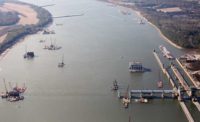When Michael Braden took over as U.S Army Corps of Engineers’ divisions chief for the Olmsted Locks and Dam in 2013, job No. 1 was getting the $3.1-billion project back on schedule. Pushed back by numerous delays and scope changes from its original 1990s timeline, the locks and dam on the Ohio River finally are scheduled to open next year.
“It’s an extremely large scope” on a stretch of river that has a high volume of water, elevation changes and murky conditions, creating “a very challenging operational environment,” Braden says.
Some observers have criticized the choice of an in-the-wet construction method for the dam. They contend that keeping the river open to most barge traffic led to an artificially short construction season and demanded precise placement of dam pieces, built on land, into murky, high-velocity water. Each year, 92 million tons of commodities travel the stretch of the Ohio where work is ongoing.
Since the 1990s, ENR has written about the quest to replace the failing locks and dams Nos. 52 and 53, respectively 85 and 86 years old, on the river just above where it meets the Mississippi at Cairo, Ill. (ENR 9/20/97 p. 20 and 11/14/11 p. 48). The replacement, Olmsted, has been both touted as a necessary, state-of-the-art modernization and characterized as a boondoggle that has caused other Corps projects to be pushed further down the road because of its increasing schedule and cost overruns. Olmsted’s original authorized cost, $775 million, was long ago surpassed, and its completion is now authorized at a cost of up to $3.1 billion.
For most replacement locks and dams built over the past century, the Corps built cofferdams to hold back the river to enable workers to work on dry river bottoms. This in-the-dry technique was used for Olmsted’s locks. From 1993 to 1995, Balfour Beatty initiated the first major construction effort by building a cofferdam to facilitate the in-the-dry construction of twin 1,200-ft lock structures by joint venture Atkinson Dillingham Lane. That work was completed in 2002.
In 2004, a cost-reimbursement construction contract, which stipulated the in-the-wet method, was awarded to a joint venture of Washington Group and Alberici. Washington Group later was acquired by URS and, ultimately, AECOM. The dam’s permanent features were fully designed by a joint venture of Jacobs Engineering and Callaway Marine Technologies, the Corps’ architect-engineer of record, but the construction means and methods presented were only concepts, requiring significant time and effort by AECOM and the Corps to fully engineer the innovation required to be successful.
For Olmsted—named for the Illinois town near the project site—the Corps and its joint-venture design team, Sverdrup-Gerwick and AECOM, embraced new methods in planning the dam’s construction. They called for precasting the up-to-3,500-ton concrete shell sections on land, then lowering them precisely into place in the river current. Corps engineers and independent analyses repeatedly have confirmed this in-the-wet technique as an effective construction method.
Getting that work done was another story, however. One challenge was placement of the concrete sections in the river. They were originally planned to be floated in on a skid system. But the concrete shells proved too fragile for such movements. An alternate method uses a supergantry crane to travel across the five precast positions in the yard and allow transfer to a specially designed cradle. It carries the shell down the incline to a catamaran barge for transport and final set-down. Strand jacks atop a 10-story supergantry, formerly the world’s largest, and the barge facilitate lifting and setting the shells precisely into place.
Then, there were the conditions. Sometimes the Ohio River was too high to get river work done, as in 2011 when it flooded. In dry years, officials say, the river would get too low, and construction would have to be suspended to let barges pass through. The construction season initially ran from May to November, and strict rules prohibited diving at any other time. The first season of diving, in 2010, was devoted almost entirely to seeing what could be done in the existing conditions.
“We require a lot of diver support for cleanup and quality control,” Braden says. “It’s very difficult to understand what that diver can do 40 feet into the water in blackout conditions with 4-feet per-second velocity. What measurements can we take? What can they do with their hands? Once we started those activities, we got a better feel for what we could do and when we could or couldn’t do them.”
AECOM self-performed on-site pile-driving and steel fabrication for the dam’s submersible sections. The company subcontracted diving and exact placement of the shell sections to Seattle-based Global Diving & Salvage, which dispatched one to two dive teams to the site. The teams worked the river 24-7 during the season. Crews line up exact coordinates using underwater sonar and GPS.
Global recently completed its 10,000th dive without incident on the project.
After a funding reauthorization in 2013, project managers were empowered to authorize changing operations outside the traditional June-to-November season.
For example, crews worked until late December, when much more water began flowing down the river, decreasing productivity and increasing safety exposure. At that point, the call was made to curtail diving operations, and the dive teams were sent home for the holidays. Diving resumed in January, due to favorable weather conditions.
When it came to programmatic changes, the Corps adopted an earned-value-management system for its 2013 reauthorization. That also set up a $250- million contingency fund if bad weather, impassable conditions or changes to the project necessitated more funding.
“Depending on the changes the team is entertaining and the impact that they have on cost and schedule, those changes have to be elevated,” Braden says. “We can make changes right now on my authority on a day-to-day basis [for already authorized spending]. But if we start dipping into that contingency fund, then it has to be elevated to my commander and our division headquarters.” If the changes are great enough, they would go to Corps headquarters.
Based on its reauthorization schedule, Olmsted was projected to be operational in 2022. But based on the current schedule, the new locks and dam will be operational in 2018, four years ahead of the risk-based schedule. The $250-million contingency fund has not yet been touched.
This year, only two concrete shell pieces remain to be placed in the dam. A cast-in-place dam section remains after that, but AECOM and USACE officials are confident the project will be operational next year. When Olmsted opens to traffic, project officials say it will deliver nearly $640 million in net annual economic benefits.
John Doyle, special counsel with law and lobbying firm Jones Walker LLP, says, “The Corps has turned the corner on that project.” If the team stays on course, it may complete the project for as much as $300 million below the $3.1-billlion estimate, says Doyle, a former top Army civil-works official. He adds,“What was a very bad news story for way too long is well on its way to turning into very good news story.”










Post a comment to this article
Report Abusive Comment